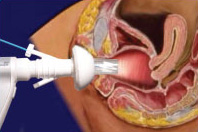Related Research Articles
Obstetrics and gynaecology or obstetrics and gynecology is the medical specialty that encompasses the two subspecialties of obstetrics and gynecology. It is commonly abbreviated as OB-GYN or OB/GYN in US English, and as obs and gynae or O&G in British English.

Gynaecology or gynecology is the medical practice dealing with the health of the female reproductive system. Outside medicine, the term means "the science of women". Its counterpart is andrology, which deals with medical issues specific to the male reproductive system.
A birthing center or centre is a healthcare facility, staffed by nurse midwives, midwives and/or obstetricians, for mothers in labor, who may be assisted by doulas and coaches. By attending the laboring mother, the doulas can assist the midwives and make the birth easier. The midwives monitor the labor, and well-being of the mother and fetus during birth. Should additional medical assistance be required the mother can be transferred to a hospital. This transfer is more likely if an epidural is needed, there is meconium staining, it is a prolonged labor, or the child needs intensive care. Some hospitals are now adding birth centers to their facilities as an alternative to the high tech maternity wards commonly found at most hospitals.
Hospital medicine is a medical specialty that exists in some countries as a branch of internal or family medicine, dealing with the care of acutely ill hospitalized patients. Physicians whose primary professional focus is caring for hospitalized patients only while they are in the hospital are called hospitalists. Originating in the United States, this type of medical practice has extended into Australia and Canada. The vast majority of physicians who refer to themselves as hospitalists focus their practice upon hospitalized patients. Hospitalists are not necessarily required to have separate board certification in hospital medicine.

The David Grant USAF Medical Center (DGMC) at Travis Air Force Base in Fairfield, California, is the U.S. Air Force’s largest medical center in the continental United States and serves military beneficiaries throughout eight western states. It is a fully accredited hospital with a National Quality Approval gold seal by the Joint Commission, and serves more than 500,000 Department of Defense and Department of Veterans Affairs Northern California Health Care System eligible beneficiaries in the immediate San Francisco-Sacramento vicinity from 17 counties covering 40,000 square miles. DGMC is named in honor of Dr. David Norvell Walker Grant, USAAF, MC (1891-1964), the first Surgeon General of the U.S. Army Air Corps and U.S. Army Air Forces.
In case of a previous caesarean section a subsequent pregnancy can be planned beforehand to be delivered by either of the following two main methods:

The Sloane Hospital for Women is the obstetrics and gynecology service within NewYork-Presbyterian Hospital and the Department of Obstetrics and Gynecology of the Columbia University College of Physicians and Surgeons (P&S) in New York City. It was originally founded in 1886 with Columbia P&S as a training and treatment center for obstetrics. It has now provided over 100 years of obstetrical care. The hospital is located within Morgan Stanley Children's Hospital.
Inpatient care is the care of patients whose condition requires admission to a hospital. Progress in modern medicine and the advent of comprehensive out-patient clinics ensure that patients are only admitted to a hospital when they are extremely ill or have severe physical trauma.

Torrance Memorial Medical Center is a private hospital located in Torrance, California. Torrance Memorial Medical Center is a Magnet designated facility recognized by the American Nurse Credentialing Center (ANCC) for quality patient care, nursing excellence and innovations in professional nursing practice. Torrance Memorial was the first hospital in the Los Angeles South Bay region, and is currently one of just three burn centers in Los Angeles County.

The Brooklyn Hospital Center is a 464-licensed-bed, full-service community teaching hospital located in Downtown Brooklyn, New York City. The hospital was founded in 1845. It is affiliated with the Mount Sinai Health System, and serves a diverse population from a wide range of ethnic backgrounds.
The Society of Obstetricians and Gynaecologists of Canada (SOGC) is a national medical society in Canada, representing over 4,000 obstetricians/gynaecologists, family physicians, nurses, midwives, and allied health professionals in the field of sexual reproductive health.

The Society of Hospital Medicine an American membership society for hospitalists, that is, physicians and other caregivers who practice the specialty of hospital medicine.

Lexington Medical Center is a medical complex in Lexington, SC. Lexington Medical Center is owned by Lexington County Health Service District, Inc, a private company. The network includes six community medical centers, an occupational health facility, the largest nursing home in the Carolinas, an Alzheimer's Disease care center and seventy physician practices in a variety of services. Lexington Medical Center's main campus is located on Sunset Boulevard in West Columbia.
The Association of Women's Health, Obstetric and Neonatal Nurses (AWHONN) is a 501(c)3 nonprofit membership organization. The stated purpose of AWHONN is to promote the health of women and newborns.
Obstetrical nursing, also called perinatal nursing, is a nursing specialty that works with patients who are attempting to become pregnant, are currently pregnant, or have recently delivered. Obstetrical nurses help provide prenatal care and testing, care of patients experiencing pregnancy complications, care during labor and delivery, and care of patients following delivery. Obstetrical nurses work closely with obstetricians, midwives, and nurse practitioners. They also provide supervision of patient care technicians and surgical technologists.
Benjamin P. Sachs is a physician with health care management experience at the Harvard Medical School hospitals and the Tulane University Medical Center.

Joseph Bolivar DeLee was an American physician who became known as the father of modern obstetrics. DeLee founded the Chicago Lying-in Hospital, where he introduced the first portable infant incubator. Early in his career, he was associated with the medical school at Northwestern University. After 1929, he was employed by the medical school at the University of Chicago.

No Pain Labor & Delivery – Global Health Initiative is a non-for-profit organization. Founded in 2006, the program focuses on correcting the unnecessarily high caesarean delivery rate and the poor utilization of neuraxial labor analgesia in China.
Obstetric anesthesia or obstetric anesthesiology, also known as ob-gyn anesthesia or ob-gyn anesthesiology is a sub-specialty of anesthesiology that provides peripartum pain relief (analgesia) for labor and anesthesia for cesarean deliveries ('C-sections').
UPMC Williamsport, formerly UPMC Susquehanna Williamsport or Williamsport Regional Medical Center, is a 24-hr emergency hospital of UPMC Susquenhana located in Williamsport, Pennsylvania. Originally established in 1873 as the Williamsport Hospital, it currently operates at least 224 beds.
References
- ↑ Ecker, Jeffrey; Keats, John (February 2016), Committee Opinion Number 657: The Obstetric and Gynecologic Hospitalist, the Committee on Patient Safety and Quality Improvement and the Committee on Obstetric Practice, The American College of Obstetricians and Gynecologists, retrieved 7 March 2018
- 1 2 Wachter, Robert M.; Goldman, Lee (15 August 1996). "The Emerging Role of "Hospitalists" in the American Health Care System". New England Journal of Medicine. 335 (7): 514–517. doi:10.1056/NEJM199608153350713. PMID 8672160.
- ↑ Annual Survey of the American Hospital Association, American Hospital Association, 2010
- ↑ Weinstein, Lewis (2003). "The Laborist: A new focus of practice for the obstetrician". American Journal of Obstetrics and Gynecology. 188 (2): 310–2. doi:10.1067/mob.2003.133. PMID 12592231.
- 1 2 Tessmer-Tuck, Jennifer A.; McCue, Brigid (May 2015). "The ob/gyn hospitalist". Contemporary OB/GYN. Retrieved October 9, 2017.
- ↑ Scheinwald; Aronson (2007), Implementing a Laborist Model: Four Case Studies, The Advisory Board Company
- ↑ "Internal Medicine Hospitalists". Questcare. Questcare Medical Services, P.A. Retrieved 7 March 2018.
- ↑ "TeamHealth Enters Strategic Partnership with St. David's Healthcare, Capitol Emergency Associates, Central Texas Hospitalists and Hospital Internists of Austin" (Press release). TeamHealth Holdings Inc. 9 February 2015. Retrieved 7 March 2018.
- ↑ "About Us". Integrated Physician Services. Memphis, Tennessee: Integrated Physician Services. Retrieved 7 March 2018.
- ↑ "The Nation's Leading Provider of OB Hospitalist Services". Ob Hospitalist Group. OB Hospitalist Group. Retrieved 7 March 2018.
- ↑ "About Us". SOGH. Society of OB/GYN Hospitalists. Archived from the original on 4 August 2015. Retrieved February 4, 2016.
- ↑ McCue, Brigid; Fagnant, Robert; Townsend, Arthur; Morgan, Meredith; Gandhi-List, Shefali; Colegrove, Tanner; Stosur, Harriet; Olson, Rob; Meyer, Karenmarie; Lin, Andrew; Tessmer-Tuck, Jennifer (February 2016). "Definitions of Obstetrics and Gynecologic Hospitalist". Obstetrics & Gynecology. 127 (2): 393–397. doi:10.1097/AOG.0000000000001235. PMID 26942370.